admirable characters
by Glenn Roberts
Photography by Glenn Roberts
|

H-D - Indian - Whizzer - IZH - Jawa - Nimbus - Puch
|
| Welcome to the third of six installments of 'Admirable Characters', a continuing series of the motorcycles from the Bar Hodgson Collection. First in this section we have the North American motorcycles and following is the miscellaneous European motorcycles that are contained in the collection. Although most in the collection are of off-shore descent, there are a few from some of North America's most famous marques, Harley-Davidson and Indian.
|
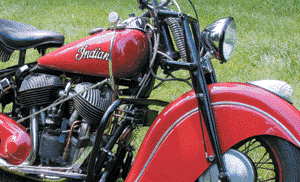 |
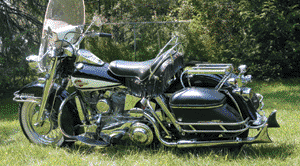
1960 Harley-Davidson FLH 'Decker' 74ci (1200cc) four stroke V-twin with period accessories. Restored by Bar Hodgson |
There have been hundreds of motorcycle manufacturers in the United States since the turn of the century. The ones that had the best possibility of survival seemed to be large displacement engines mounted into large bulky frames. In comparison to their European counterparts, many of these are downright massive. Of the motorcycles shown here, all in the American section are a minimum of 1000cc (61ci) with the exception of the U.S. made Whizzer. Even in 1912 Harley-Davidson had a 1000cc engine when many of the European manufacturers were producing sub-500cc engines. Maybe because of the wide open spaces and longer straighter roads in North America the larger engined motorcycles became more acceptable as opposed to Europe where smaller roads used to be and still were at the time, horse and buggy paths. After all, driving from town to town in North America can take as long as driving from country to country in Europe.
|
|
It's ironic that the small displacement motorcycles from overseas were one of the reasons Harley-Davidson fell into financial troubles in the fifties and sixties and Harley-Davidson tried to counter by building and importing small displacement motorcycles. Today all of the main off-shore manufacturers provide models with large displacement engines to the North American market that are larger than the biggest stock Harley-Davidson.
|

FLH: The 'FL' designation started in 1942 with the introduction of the 74ci (1200cc) Knucklehead. The 'H' designation was originally given to the 'super sport' tuned engine in 1954. The FLH was, and still is, H-D largest and most comfortable touring motorcycle.
|
Harley-Davidson: The history of Harley-Davidson is a long and illustrious one and far too vast for these few pages. There are many excellent books on the subject of the Motor Company at most book stores for those who wish a more complete history.
Since the engine is one of the reasons, if not the main reason, the company is so well recognized I will give a brief history of the most famous of their engine designs, the 45 degree air cooled V-Twin.
|
|
The first H-D configuration of V-Twin the company produced was in 1909. A few different V-Twin configurations emerged from that initial design but today's
engine is an advanced derivative of the 'Knucklehead' first introduced in 1936. The 1000cc and 1200cc Knucklehead engines were produced until 1947 and were the first H-D engine with a combination of a 45 degree air cooled V-Twin with push rod actuated overhead valves and a dry sump lubrication system.
|
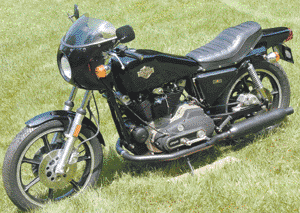
1978 H-D XLCR 61ci (1000cc) four stroke V-twin. Harley's 'Cafe' styled sport bike was built as a design exercise by Willy 'G' Davidson. Note the exhaust |

XLCR: The XL is derived from Sportster lineage and the CR stands for 'Cafe Racer'. Far from traditional Harley-Davidson design with its nose fairing and alloy wheels, the XLCR was only produced in '77 and '78 in very limited numbers and never became a commercial success although they are highly sought after by today's motorcycle collectors.
|
The engine was called the Knucklehead because of the shape of the rocker covers resemble the knuckles of a clenched fist.
In 1947 the 1200cc Panhead, obviously named for the apparent upside-down pans used for rocker covers, was released. The Panhead featured hydraulic valve adjusters, alloy cylinder heads for better cooling and a better lubrication system.
The new engine also boosted horsepower to 50hp, 10hp over the Knucklehead.
The Panhead stayed in production for an amazing 18 years and to some H-D affectionados is one of the most visually appealing engines to be produced by the Motor Company. |
|
The 1200cc Shovelhead was released in 1966 with better carburetion, higher compression and different rocker boxes, again the reason for the name. The rocker boxes loosely resembled a spade shovel missing the handle. The revised engine design again delivered an increase of 10hp over the previous engine design. The next release of V-Twin power was in late 1983 in the form of the 1340cc Evolution engine. The 'Evo' engine was the most oil tight and reliable revision to date of the 47 year old design.
|
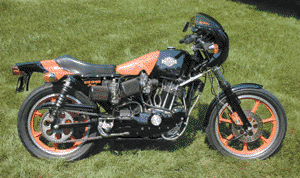
1978 H-D XLCR/XR1000
61ci (1000cc) four stroke V-twin. Highly modified XLCR built by Iron Works Magazine using a Gerry Branch Stage II XR1000 engine. |
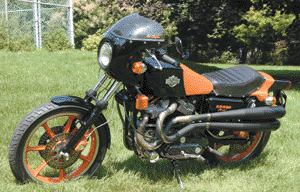
|
The 1450cc Twin Cam 88 was first seen on the road in 1999 and is the current version of H-D big twin power that is a direct descendant of the original Knucklehead. The Twin Cam is still an overhead valve engine with the camshafts in the block and comes in two configurations, with balance shafts for the solid mounted engines and without balance shafts for the rubber mounted engines and, of course, has a power advantage over the previous Evolution engine.
|
|
Indian: George Hendee and Oscar Hedstrom founded the Hendee Manufacturing Company in 1900. In 1901 the company produced 6 motorcycles and sold 3 of them. By 1915 they were the largest motorcycle producer in the world producing almost 32,000 units per year. 1906 saw the introduction of the V-Twin engine out of customer demand for more power. As other V-Twin's of the day it was basically a single cylinder engine with the second cylinder grafted onto a single cylinder block.
|
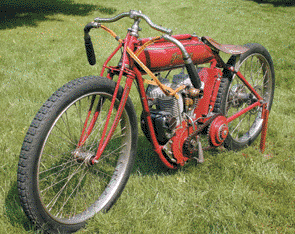
1920 Indian 'Boardtracker' 61ci (1000cc) four stroke V-twin. Factory Board-Track racer running on alcohol. Full throttle only, no transmission, no clutch and no brakes.
Restored in Canada by Al Fair.
|
Indian entered into racing early in the century recognizing that racing was the best way for the public to recognize their existence and reliability. In 1911 at the Isle of Man TT they took first, second and third place beating the British. Indian also had a long standing relationship with police departments and the U.S. military.
|
| Board Track racers: These bikes only purpose was to travel fast in an oval track made of wood boards. Over the years the tracks would get chewed up and splintered, oil soaked and slippery. The bikes featured a wide open throttle, no clutch or transmission and brakes were non-existent, only a kill switch to stop the engine. It's no wonder so many men lost their lives competing in such races as well as many a spectator when the bikes left the track and crashed into the crowd.
|

|
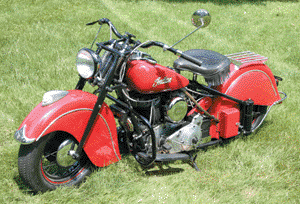
1947 Indian Chief 74ci (1200cc) four stroke V-twin. This bike was ridden by Bill Lishman in the movie 'Fly Away Home'.
|
Indian is best known for the Chief, Scout and the Four. The Four used a longitudinal in-line four cylinder engine. They had many other engine configurations over their distinguished history including a flat twin and many single cylinder engines.
|
|
Indian Chief: Universally recognized by the large skirted front fender and the Indian head which sits on top of it. Introduced in 1921 with a 1000cc engine it was a powerful fast motorcycle.
|

|
|
Whizzer: Whizzer began production in 1939 by incorporating a side valve engine that could be mounted on a standard bicycle frame. On early models, the engine's power was delivered via belt to a roller that was in contact with the rear tire easing the effort of pedaling the bicycle.
|
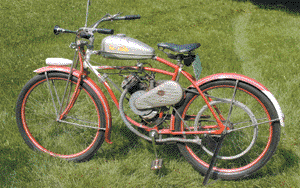
1948 Whizzer Roll Fast 150cc four stroke single.
|
Later models used a flywheel and pulley system on the rear wheel to deliver power via a jockey pulley to adjust the belt tension on the rear wheel.
The onset of European and Japanese mopeds set the stage for the Whizzer plant's closure in 1962.
|
|
This one original owner bike, from Springhill, Nova Scotia, was lightly crashed on its first journey, the repairs were made and it was never used again. All supporting paperwork including the police incident report and the repair and parts receipt are still with the bike. It still has its 1948 license plate mounted.
|
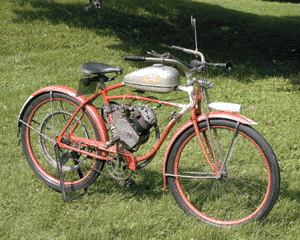
These bikes were sold complete or as a bolt-on motor and drive kit for a donor bicycle. |
|
The previous two issues of the 'Admirable Characters' series covered the English and German bikes contained in the collection and a future edition of the series will feature the fascinating bikes from Italy rounding out the collections's collection of consumer motorcycles from Europe. In this issue we cover some of the collections misc. motorcycles, the stragglers if you will, from Europe that spread themselves out over many countries.
|

|
Because of wars in the first half of the century, Europe has had many different financial climates. If the continent wasn't being blown apart it was being put back together. Many of the factories would have to change the focus of their production to help the war effort, either by mass producing the product they currently built or changing completely the goods they manufactured. It was indeed a learning curve and usually for the better as necessity forces the need for more efficient and affordable machines. The poor economies prompted cheap transportation, the type that could be manufactured inexpensively and a type of transport that was economical to operate. By American standards, many European motorcycle manufacturers produced small displacement engines. Large or small, the bottom line was mobility, fun and freedom. Come to think of it, it isn't much different than today.
|
|
IZH Planet: This company started in 1933 in the USSR town of Izhevsk which is where the name came from, the first three letters of the town name. IZH did as many Soviet motorcycle companies of the era did, they copied the technology of other manufacturers and the early bikes from IZH were direct take-off's of Germany's DWK. After WWII, IZH began producing ISDT racing versions using regular production parts but in the 1960's made specialized bikes with winning in mind.
|
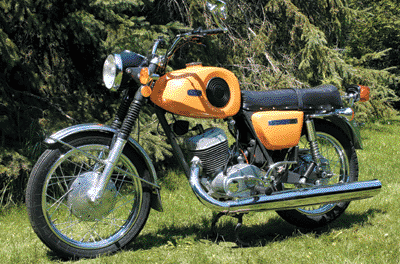
1980 IZH Planeta Sport
|

350cc two stroke single. This bike is brand new.
|
These ISDT inspired motorcycles proved very successful winning gold medals in international competition for the Soviet teams. The Planeta line started in 1962. In 1971 to 1975 the plant expanded with a modern assembly line and increased production. This is when the Planeta Sport was introduced using IZH's own technology and was far removed from DKW technology. IZH continues to produce motorcycles and are very popular in the Middle East, Far East, Eastern Europe, Central Africa and South America.
|
|
Jawa: Frantisek Janecek was an arms manufacturer in Czechoslovakia who in 1929, like so many other munitions makers, decided to start building motorcycles. Janecek bought the rights to produce the Wanderer brand and the name Jawa is a derivative of the two names, JAnecek and WAnderer. Jawa became the best known of all Czechslovakian motorcycle marques.
|
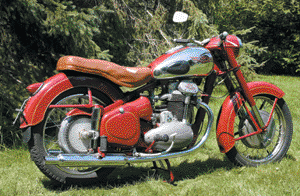
1955 Jawa OHC Twin
500cc Bevel-drive overhead camshaft four stroke twin.
|
During WWII, Jawa secretly began designing and developing a new motorcycle. One of these designs was a 250cc model with ultra-modern unit construction, automatic clutch, telescopic front fork and plunger rear suspension. After WWII the company fell under communist rule but after a few years were authorized to compete in racing. Jawa cleaned up in the ISDT for many years. They didn't have as much success in road racing.
|
|
Although two stroke engines were the company's mainstay, they did produce a 488cc double overhead cam 4-stroke engine in 1952. 1953 saw a power increase to 28hp and 1954 saw a dual seat and larger brakes. The new 500 OHC Twin was a prestigious bike but sales were slow and production of the 500 Twin ended in 1958.
|

Restored in Czechoslovakia by Radim Bager.
|
|
Nimbus with Bender Sidecar: Denmark's Nimbus began producing motorcycles in 1919 and was that countries leading motorcycle manufacturer. The first 746cc inlet-over-exhaust in-line 4-cylinder engine powered bikes were designed with functionality over styling in mind. Early models even had a swinging arm rear suspension years before other manufacturers.
|
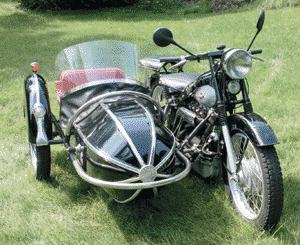
1952 Nimbus with Bender sidecar.
750cc four stroke in-line four.
Features 'exposed' valves and shaft drive.
|
Revamping the plant into a modern facility in 1934 allowed Nimbus to produce the new MkII model. The MkII used a modified engine from the previous design and incorporated an overhead cam, overhead valves and a hemispherical combustion chamber. Being an air cooled longitudinally mounted engine, overheating problems were obvious on long hard rides, evident by the extreme cylinder head warping. Although the engine did not produce an enormous amount of power it was well suited to effectively handle a sidecar.
|
|
The new MkII frame lost its swinging arm rear suspension and the heavy tube frame gave way to a riveted steel strip frame as the model shown here illustrates.
The MkII design lasted until the company closed its doors in 1958 and in the 24 years of production, the MkII's parts were interchangeable. Even after the plant closed it still produced parts for the MkII in order to fulfill Danish military contracts.
|
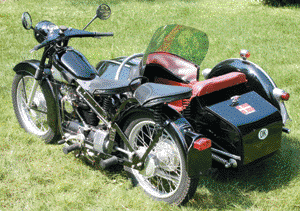
1952 Nimbus with Bender sidecar.
Designed in the '30's.
Restored by Carl Hansen.
|
|
Puch: Johann Puch founded the Austrian company in 1891 manufacturing bicycles and the company was sold in 1897. The company produced its first motorcycle in 1903 followed by its first automobile in 1910. Puch was active in racing with moderate success.
|
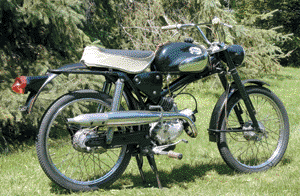
1964 Puch/Allstate
60cc two stroke single. Note the shrouded engine. The engine is cooled by an engine driven fan behind the left side louvered cover ensuring cooling even when stopped in traffic.
|
Puch designed the first split single nicknamed the 'twingle' in 1923, an engine design that lasted for almost 50 years. In order to increase engine size, Puch doubled up a 250cc engine into a 500cc four-piston split-twin.
|
|
Troubled auto component manufacturer Austro-Daimler joined Puch in 1928 and armament manufacturer Steyr joined Puch in 1934. Puch was one of Europe's leading motorcycle manufacturer when WWII broke out.
|

|
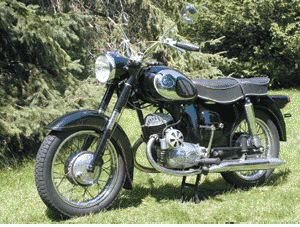
|
After WWII, Puch exported the split-single to North America and Europe. The bikes were sold under the Allstate brand name and could be purchased in Simpson-Sears stores in Canada and the Sears Chain Store Company in the United States.
|
|
In the 1970's, Puch focused production on mopeds but after being purchased in 1987 by Italian company Piaggio, the factory was closed.
|
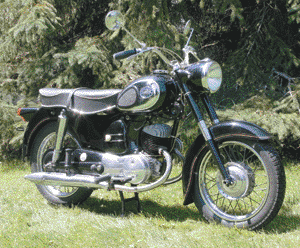
1965 Puch/Allstate - 175cc two stroke 'twingle'. Featuring a very unusual engine design; two pistons on a common connecting rod in parallel in-line bores.
|
Originally published in Motorcycle Mojo Magazine, by author and photographer Glenn Roberts, reproduced here with kind permission.
|

 Over the coming year we will be featuring an extensive photographic presentation of bikes from the Bar Hodgson Collection assembled by country of origin as originally published in Motorcycle Mojo Magazine, author and photographer Glenn Roberts, reproduced here with kind permission. This presentation of the third in the series features the American and European Bikes originally published in the March/April 2005 issue of Motorcycle Mojo Magazine.
Over the coming year we will be featuring an extensive photographic presentation of bikes from the Bar Hodgson Collection assembled by country of origin as originally published in Motorcycle Mojo Magazine, author and photographer Glenn Roberts, reproduced here with kind permission. This presentation of the third in the series features the American and European Bikes originally published in the March/April 2005 issue of Motorcycle Mojo Magazine. 























